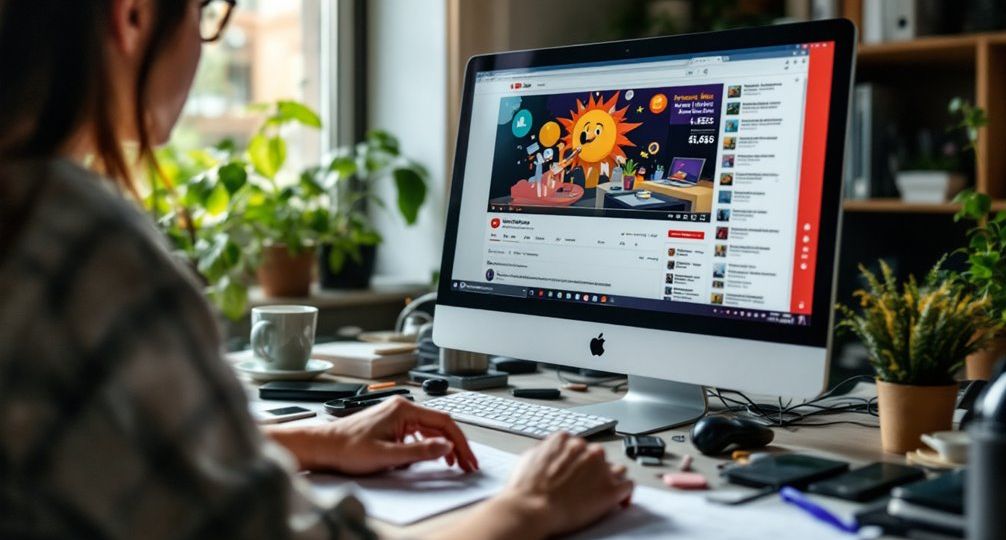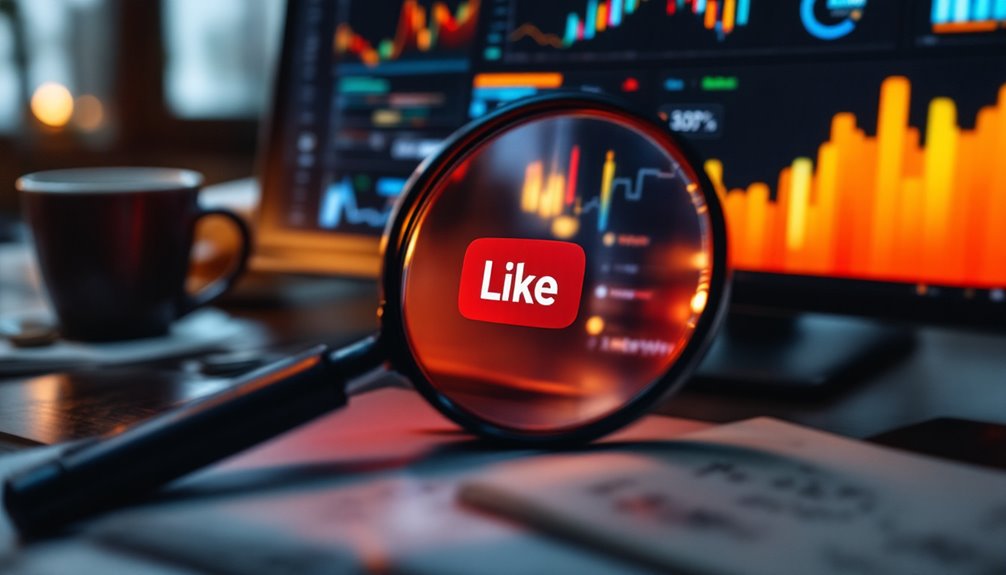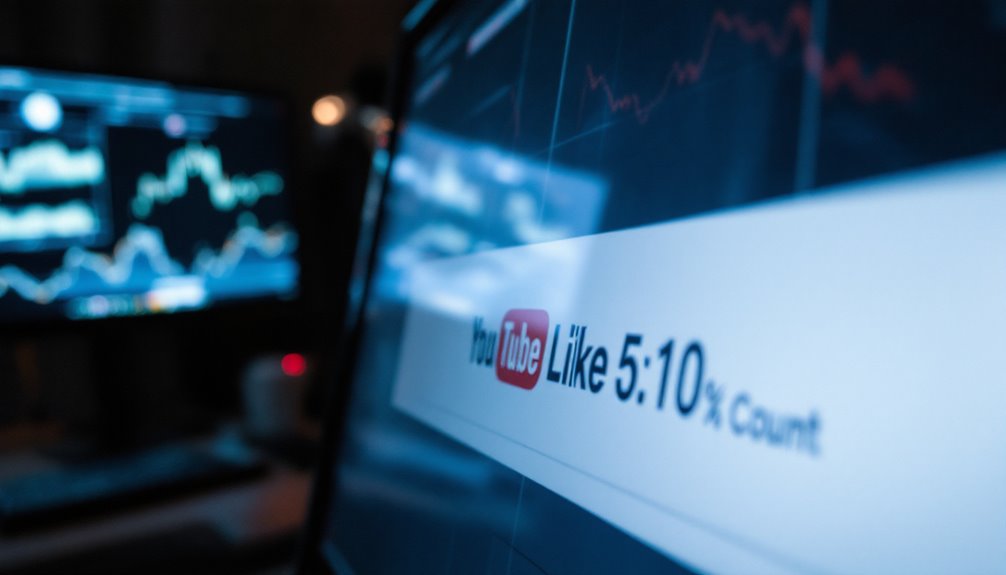
Can YouTube detect fake likes?
You might wonder if YouTube can spot fake likes, and it turns out, it can. The platform uses sophisticated algorithms that scrutinize user behavior and interaction patterns. By tracking IP addresses, analyzing the timing of interactions, and evaluating the legitimacy of user profiles, YouTube identifies suspect activity that hints at bot-generated likes. Unusual spikes in likes without matching views or comments also raise alarms. Curious about how these mechanisms impact content authenticity?
Key Takeaways
- YouTube algorithms analyze behavioral patterns to detect fake engagement, including likes, views, and comments.
- Sudden spikes in likes without matching view counts raise suspicion of artificial engagement.
- Analysis of IP addresses and user behavior helps identify multiple fake likes from a single source.
- Profiles with minimal details or activity and generic usernames are scrutinized for potential bot activity.
- Detection of fake likes ensures fairness in content distribution and preserves platform integrity.
Detection Mechanisms and Algorithms

While many users mightn’t notice, YouTube’s algorithms are hard at work detecting and flagging potential fake engagement. Through sophisticated algorithmic detection, these systems scrutinize user behavior patterns, identifying anomalies that suggest engagement manipulation. By continuously evolving, they stay one step ahead of those attempting to game the system. YouTube’s algorithms analyze IP addresses, pinpointing multiple likes from a single source, and monitor the time interval between views and likes to expose bot activity. The platform’s innovative approach ensures quick and reliable results in maintaining content integrity. They also evaluate content authenticity to ensure that interactions are genuine and not artificially inflated. YouTube leverages behavioral trends to guarantee authentic interactions. By examining likes-to-comments ratios and verifying user profiles, it distinguishes genuine users from bots. These detection mechanisms are integral to preserving the platform’s integrity, guaranteeing that content engagement reflects real user interest and not manipulated statistics.
Identifying Patterns of Artificial Engagement
YouTube’s commitment to maintaining authentic engagement goes beyond algorithmic detection to include identifying patterns of artificial interactions. By analyzing engagement tactics, YouTube can evaluate strategies that indicate fake likes. Sudden spikes in likes or comments without matching view counts raise red flags. Such anomalies often involve new or inactive accounts, suggesting orchestrated efforts rather than organic interest. Lockstep behavior, where accounts target the same videos simultaneously, is another indicator. A system like LEAS can map accounts and their engagement relationships, helping YouTube identify patterns of coordinated actions among accounts. YouTube’s engagement relationship graph maps these connections, identifying suspicious patterns over time. A skewed likes-to-comments ratio further highlights potential deception, as real engagement typically includes balanced interactions. Evaluating these patterns guarantees that YouTube effectively discerns genuine user interest from artificial manipulation, preserving the platform’s integrity.
Analyzing User Behavior for Authenticity

Analyzing user behavior for authenticity involves examining data trends in user interactions, such as the timing and frequency of likes and comments. You can identify behavioral patterns by looking for unusual metrics and engagement discrepancies. Detecting anomalous interactions involves monitoring for inconsistencies, like sudden spikes in likes without a corresponding increase in views or comments. Sudden spikes in likes are often a sign of artificial boosting, which can undermine the authenticity of engagement.
Identifying Behavioral Patterns
Understanding YouTube’s ability to detect fake likes requires an in-depth exploration into the analysis of user behavior patterns. By engaging in behavioral analysis, YouTube monitors engagement patterns, such as the likes-to-comments ratio, to assess authenticity.
A disproportionate number of likes with minimal comments often signals fake engagement. Consistency in engagement rates, like likes and comments per video, is essential. When videos experience sudden spikes in likes without corresponding increases in views or comments, it raises red flags.
The timing of likes is scrutinized, with large numbers appearing shortly after posting often deemed suspicious. Additionally, profiles lacking personal details or displaying minimal activity are examined closely, as they may indicate bot accounts. YouTube also considers cookie settings when assessing user interactions to help tailor content and identify potential fake engagement.
This thorough approach allows YouTube to maintain authentic user interactions.
Detecting Anomalous Interactions
Detecting anomalous interactions can be complex, but analyzing user behavior for authenticity provides critical insights into engagement patterns. YouTube employs advanced anomaly detection to scrutinize user interactions, flagging spikes in likes that lack corresponding views or comments. Interaction analysis reveals that multiple likes from a single IP or rapid liking behavior without content consumption suggest fraudulent activity. Anomalies in like-to-view ratios and engagement metrics like the like-to-comments ratio serve as red flags. Genuine engagement leads to better brand awareness and conversions, making it essential to differentiate between authentic and inauthentic interactions. Consistent engagement over time is key to authenticity, while inconsistent patterns draw suspicion. Evaluating user profiles further aids detection, as profiles with minimal information or irregular activity often indicate bots. This thorough analysis guarantees more authentic engagement, protecting the platform’s integrity.
Consequences of Manipulated Likes
When fake likes are detected on YouTube, the consequences can be severe, impacting both the channel’s integrity and its future prospects. Engaging in fake likes poses significant fake engagement risks and can erode audience trust.
This manipulation can lead to:
- Channel termination: Permanent removal if fake engagement is identified.
- Monetization impact: Loss of monetization due to breached terms of service.
- Distorted analytics: Skewed data complicates understanding real audience behavior.
- Credibility damage: Audience perception shifts negatively, harming reputation.
- Algorithmic demotion: Reduced promotion due to unnatural engagement patterns.
These outcomes highlight how artificial likes can mislead both viewers and the platform’s algorithms, ultimately diminishing your channel’s potential for genuine growth and innovation.
Prioritizing authentic engagement is vital for maintaining a trustworthy and successful channel.
Understanding Algorithm Capabilities

Recognizing the severe consequences of manipulated likes, it’s imperative to explore how YouTube’s algorithms manage to identify and address such fraudulent activities.
The platform’s algorithm performance is finely tuned to detect fake engagement. It tracks behavior patterns, scrutinizes IP addresses, and analyzes the duration between views and likes to guarantee detection accuracy.
By examining user engagement beyond mere likes—considering comments and shares—YouTube verifies authenticity and distinguishes real interactions from fraudulent ones. The system’s ability to trace likes back to their source allows it to efficiently remove bot-generated likes.
Advanced algorithmic learning further refines these capabilities, using AI to maintain platform integrity and transparency. Anomalies in metrics signal potential issues, guaranteeing genuine content thrives.
Spotting Discrepancies in Engagement Metrics
How can you effectively spot discrepancies in engagement metrics on YouTube? Engaging in metric analysis is essential for identifying fake likes. YouTube actively monitors invalid traffic to distinguish genuine engagement, utilizing automated systems and manual data processing. Look for signs of engagement consistency to guarantee your audience interaction is genuine. Pay attention to:
- Sudden spikes in likes without a corresponding increase in views or comments.
- High like-to-view ratios with few comments or shares.
- Inconsistent comment trends despite many likes.
- Viewer demographics that don’t align with your content’s language or target audience.
- Anomalies in like-to-view ratios, as they could indicate counterfeit metrics.
Examining Account Characteristics

Although the digital landscape is vast, examining account characteristics on YouTube reveals critical insights into distinguishing authentic interactions from fake ones.
You can start with profile picture analysis; fake accounts often lack this simple element. Minimal information indicators, such as generic usernames and scant personal details, are also red flags. These accounts typically have few followers and no uploaded content, further suggesting inauthenticity.
Moreover, watch for unusual activity patterns, like multiple likes in quick succession. These behaviors often align with automated actions rather than genuine user engagement.
The Impact on User Experience
Fake likes can greatly distort your YouTube experience by undermining the authenticity and trustworthiness of content recommendations. When the algorithm is misled by artificially inflated metrics, fairness in content distribution suffers, often promoting less relevant videos that don’t match your interests. This misalignment not only affects viewer perception and credibility but also erodes trust, as users may feel deceived by the misleading popularity of certain videos. With YouTube’s advanced algorithms, the platform can often detect such fraudulent activities, but the damage to user experience and trust can still be significant.
Authenticity and Trustworthiness
When you engage with YouTube content, the platform’s integrity and trustworthiness play an essential role in shaping your experience. Fake likes can distort this, impacting creator integrity and audience loyalty. The platform’s algorithms are vigilant, detecting anomalies to guarantee genuine engagement. This vigilance maintains an environment where trust is built upon authentic interactions. Understanding audience needs and values is crucial for creating authentic content that resonates deeply with viewers’ emotions and experiences, ensuring genuine connections between creators and viewers.
- Creator integrity is compromised by artificial boosts, skewing true content value.
- Audience loyalty diminishes as viewers become skeptical of inflated metrics.
- Algorithmic distortions lead to uneven content visibility, impacting fairness.
- User perception is affected, with fake popularity misleading content quality.
- Ethical violations undermine the core values of honest digital engagement.
Fairness in Content Distribution
As YouTube works to guarantee fairness in content distribution, its algorithms play a pivotal role in detecting and mitigating fake likes that can skew user experience. By analyzing user behavior patterns, YouTube identifies unnatural spikes in likes, securing content fairness.
Fake likes can disrupt distribution equity by unfairly boosting video visibility, leading to a ‘rich-get-richer’ effect where less deserving content gains undue attention. This undermines genuine creators, as false metrics mislead the recommendation system, overshadowing authentic user interests.
The ongoing battle against such fraudulent tactics requires continuous algorithm refinement to preserve distribution equity. YouTube’s commitment to refining these algorithms secures that genuine content receives the attention it deserves, maintaining a balanced ecosystem where user preferences are accurately represented.
Viewer Perception and Credibility
Have you ever noticed how some videos seem more popular than they actually are? Fake likes can inflate a video’s appeal, leading to viewer skepticism and a distorted sense of creator credibility.
When you encounter videos with suspiciously high like counts, you might question their authenticity. This skepticism is rooted in several key impacts:
- Misleading popularity influences your choices, often leading to disappointment.
- Trust in platform recommendations is undermined, affecting your overall experience.
- Channels relying on fake likes risk long-term credibility loss.
- Advertisers may avoid partnerships with creators suspected of artificial engagement.
- Authentic creators feel undervalued, impacting the quality of genuine content.
Understanding these dynamics is essential for fostering an innovative YouTube ecosystem where credibility and user trust thrive.
Anomalies in Like-to-View Ratios

A sudden spike in likes on a YouTube video, especially when unexplained, can be a clear indicator of fake engagement. Like manipulation disrupts the average like-to-view ratio, typically around 4%, raising suspicions when significant deviations occur. Such anomalies can skew perceived popularity, exploiting YouTube’s algorithms and promoting misleading content. This undermines engagement integrity, eroding trust.
YouTube’s detection methods are robust, tracking user behavior for unnatural patterns. Algorithms scrutinize IP addresses for multiple likes from a single source, and bots often generate likes without views, revealing discrepancies in engagement metrics.
Additionally, a lack of comments or shares alongside high likes signals potential issues. Identifying these anomalies is essential to preserving the platform’s authenticity and user trust.
Verifying Content Authenticity Through Engagement
How can you be certain that the engagement you’re seeing on YouTube is genuine? By analyzing engagement metrics and confirming content originality, you can verify the authenticity of interactions.
YouTube’s algorithms scrutinize user behavior to combat fake likes and boost platform integrity. Here’s how:
- User Behavior Analytics: Examine interaction patterns to identify genuine engagement.
- Content Authenticity Checks: Analyze videos and comments for originality to avoid duplication.
- Detecting Artificial Interactions: Spot sudden spikes in metrics that suggest bot activity.
- Maintaining Platform Integrity: Use refined algorithms to trace and remove bot-generated likes. Digital tools like plagiarism checkers can be used to verify video content’s originality, enhancing content authenticity checks.
- Evaluating User Profiles: Look for anomalies like lack of profile pictures or unusual activity.
These strategies confirm that the engagement you see truly reflects interest and interaction.

